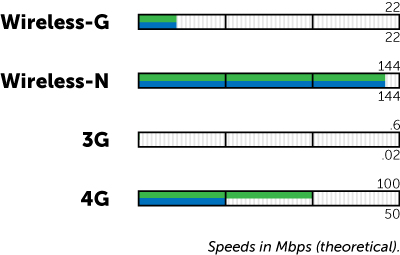-
-
products
-
resources
-
support
-
company
-
The Definitive Guide on Wireless Speeds
By Steve Horton April 08, 20113g, 4g, wifi, wirelessNo Comments Illustration: Gordon McAlpin
Illustration: Gordon McAlpinWireless-G, Wireless-N, 3G, 4G. So many different words for so many different wireless speeds. So just how fast are we talking?
WI-FI
You know those letters you sometimes see when referring to Wi-Fi? A/B/G/N. What does it mean? Well, there’s really only two you need to worry about: G and N.
WIRELESS-G
Wireless-G is an older WiFi standard that most home cable modems and DSL routers have. Many Internet providers have yet to move on to the faster Wireless-N, so you’re looking at about 22 megabits per second on the average Wireless-G network. That means that every second, this kind of Wi-Fi can upload or download 22 megabits, or 2.75 megabytes.
This speed is reduced further by the wired network that’s giving out the Wi-Fi in the first place, so actual speed is usually much slower. Wireless-G will run into problems with streaming video from places like Netflix, and will also cause issues when playing online games, especially ones where any sort of “lag” or delay in Internet speed can mean virtual life or death.
WIRELESS-N
Wireless-N is a newer standard, as you can tell as it’s further along the alphabet than G. Often, you’ll need to buy your own router and plug it in to your cable modem or DSL router to make use of its faster speeds. Wireless-N usually has two antennas for a much stronger signal. With Wireless-N, you’re looking at speeds of about 144 Mbps, much greater than Wireless-G, which means that streaming Internet video, online games and so on will work with far fewer hitches. And since it runs on two “channels” at the same time (hence, two antennas), you’re likely to have a much stronger signal. Older phones and game consoles and laptops that have Wi-Fi may not support Wireless-N out of the box, but newer machines do. For example, the X-Box 360 once had a Wireless-G attachment sold separately, but now it has a Wireless-N attachment.
MOBILE BROADBAND
Mobile broadband is another name for the Internet that your phones pick up out of the air. 3G and 4G are standards used by the mobile phone industry for their wireless data. These are designed to be used in places where there might not be a Wi-Fi signal, and as long as you’re subscribed to the mobile phone service with a data plan, and have a clear signal, then you’ll have Internet.
3G
Having Internet anywhere comes at a price, as 3G doesn’t approach Wi-Fi speeds. Assuming you have a strong mobile phone signal, you’re looking at a download speed of 0.6 Mbps and an upload speed of .02 Mbps. Not very fast, especially if you’ve got multiple devices sharing that signal. But it’ll do in a pinch, and if you’ve got enough patience, you can even share 3G with other devices by tethering.
4G
4G is the latest thing, and AT&T and the other mobile phone companies are swiftly building it across the country. What 4G means exactly differs from company to company. AT&T has an enhanced versiong of 3G and calls it 4G, but this only gets up to 28 Mbps downloading and 22 Mbps uploading. Real 4G, which will be in most major cities by the end of 2011, can get up to 100 Mbps downloading and 50 Mbps uploading, which means that 4G will fall somewhere between Wireless-G and Wireless-N Wi-Fi as far as speed. Being able to pick up Wi-Fi quality speed anywhere you want will come in really handy for a lot of people.
IT’S ALL IN THEORY
Keep in mind that the speeds listed above are theoretical maximums, and wherever you’re getting Internet, the Internet Service Provider may be limiting or capping the speed further. It’s still the case that a good wired Internet connection will have less lag and higher speeds than wireless Internet, though the gap is closing as time goes by. It may be that we will soon live in a world where wired Internet is obsolete, and everyone connects wirelessly at the same speeds. It won’t take long.
Was this post helpful?YesNoFree Driver Updates
Update your drivers in less than 2 minutes to enjoy better PC performance - Free.
Free Driver Updates
Update your drivers in less than 2 minutes to enjoy better
PC performance - Free.
Didn't find your answer?Ask a question to our community of experts from around the world and receive an answer in no time at all.most relevant recent articles Pin It on Pinterest
